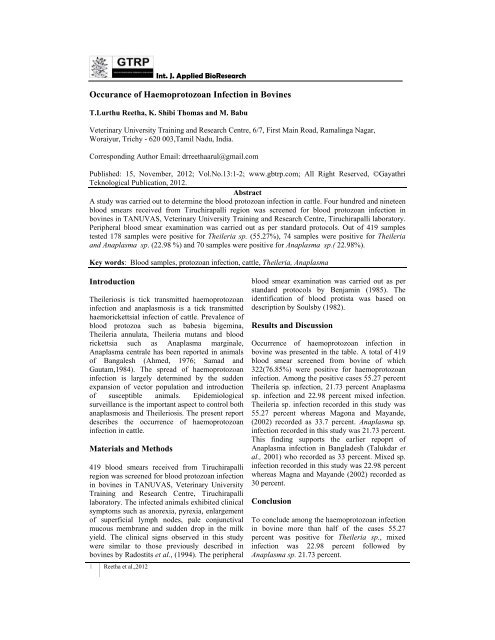Download PDF - Gayathri Teknological Publications
Download PDF - Gayathri Teknological Publications
Download PDF - Gayathri Teknological Publications
You also want an ePaper? Increase the reach of your titles
YUMPU automatically turns print PDFs into web optimized ePapers that Google loves.
Int. J. Applied BioResearch17Occurance of Haemoprotozoan Infection in BovinesT.Lurthu Reetha, K. Shibi Thomas and M. BabuVeterinary University Training and Research Centre, 6/7, First Main Road, Ramalinga Nagar,Woraiyur, Trichy - 620 003,Tamil Nadu, India.Corresponding Author Email: drreethaarul@gmail.comPublished: 15, November, 2012; Vol.No.13:1-2; www.gbtrp.com; All Right Reserved, ©<strong>Gayathri</strong><strong>Teknological</strong> Publication, 2012.AbstractA study was carried out to determine the blood protozoan infection in cattle. Four hundred and nineteenblood smears received from Tiruchirapalli region was screened for blood protozoan infection inbovines in TANUVAS, Veterinary University Training and Research Centre, Tiruchirapalli laboratory.Peripheral blood smear examination was carried out as per standard protocols. Out of 419 samplestested 178 samples were positive for Theileria sp. (55.27%), 74 samples were positive for Theileriaand Anaplasma sp. (22.98 %) and 70 samples were positive for Anaplasma sp.( 22.98%).Key words: Blood samples, protozoan infection, cattle, Theileria, AnaplasmaIntroductionTheileriosis is tick transmitted haemoprotozoaninfection and anaplasmosis is a tick transmittedhaemorickettsial infection of cattle. Prevalence ofblood protozoa such as babesia bigemina,Theileria annulata, Theileria mutans and bloodrickettsia such as Anaplasma marginale,Anaplasma centrale has been reported in animalsof Bangalesh (Ahmed, 1976; Samad andGautam,1984). The spread of haemoprotozoaninfection is largely determined by the suddenexpansion of vector population and introductionof susceptible animals. Epidemiologicalsurveillance is the important aspect to control bothanaplasmosis and Theileriosis. The present reportdescribes the occurrence of haemoprotozoaninfection in cattle.Materials and Methods419 blood smears received from Tiruchirapalliregion was screened for blood protozoan infectionin bovines in TANUVAS, Veterinary UniversityTraining and Research Centre, Tiruchirapallilaboratory. The infected animals exhibited clinicalsymptoms such as anorexia, pyrexia, enlargementof superficial lymph nodes, pale conjunctivalmucous membrane and sudden drop in the milkyield. The clinical signs observed in this studywere similar to those previously described inbovines by Radostits et al., (1994). The peripheral1 Reetha et al.,2012blood smear examination was carried out as perstandard protocols by Benjamin (1985). Theidentification of blood protista was based ondescription by Soulsby (1982).Results and DiscussionOccurrence of haemoprotozoan infection inbovine was presented in the table. A total of 419blood smear screened from bovine of which322(76.85%) were positive for haemoprotozoaninfection. Among the positive cases 55.27 percentTheileria sp. infection, 21.73 percent Anaplasmasp. infection and 22.98 percent mixed infection.Theileria sp. infection recorded in this study was55.27 percent whereas Magona and Mayande,(2002) recorded as 33.7 percent. Anaplasma sp.infection recorded in this study was 21.73 percent.This finding supports the earlier repoprt ofAnaplasma infection in Bangladesh (Talukdar etal., 2001) who recorded as 33 percent. Mixed sp.infection recorded in this study was 22.98 percentwhereas Magna and Mayande (2002) recorded as30 percent.ConclusionTo conclude among the haemoprotozoan infectionin bovine more than half of the cases 55.27percent was positive for Theileria sp., mixedinfection was 22.98 percent followed byAnaplasma sp. 21.73 percent.
Int. J. Applied BioResearch17Table-1: Occurrence of haemoprotozoan infection in bovinesYear Samples tested Theileria sp. Anaplasma sp. Mixed (Theileria, andAnaplasma sp.)Number Number Positive % Positive % Positive %examined positive2003 60 49 22 44.90 9 18.37 18 36.732004 89 64 30 46.88 17 26.56 17 26.562005 119 93 49 52.69 21 22.58 23 24.732006 82 69 44 63.77 18 26.09 7 10.142007 46 31 24 77.42 - - 7 22.582008 23 16 9 56.25 5 31.25 2 12.5Total 419 322 178 55.27 70 21.73 74 22.98AcknowledgementsAuthors are thankful to the authorities ofTamilnadu Veterinary and Animal SciencesUniversity, Chennai for the facilities provided.Manuscript Progress DateReceived : 12.07.2012Revised : 25.08.2012Accepted : 13.10.2012ReferencesAhmed, A.K. 1976. Blood parasites of domesticanimals in Bangladesh. Bangladesh VeterinaryJournal, 10: 69-71.Benjamin, M.M. 1985. Outline of VeterinaryClinical Pathology. 3 rd dn. Kalyani Publishers,New Delhi.,pp:26-37Magona, J.W. and Mayende, J.S. 2002.Occurrence of concurrent trypanosimosis,theleriosis, anaplasmosis and helminthosis inFrisian, Zebu and Sahiwal cattle in Uganda.Onderstepoort J . Vet. Res., 1- 3.Radostits, O.M., Blood, D.C. and Gay, C.C. 1994.Veterinary Medicine , A text book of the diseasesof Cattle , Sheep, Goats, Pigs and Horse, 8 th edn.ELBS, Baillier, London.Samad, M.A and Goutam O.P. 1984. Prevalenceof Theleria annulata infection in cattle ofbangladesh . Indian Journal of Parasitology,7: 61-63Soulsby, E. J. L. 1982. Helminths, Arthropods andProtozoa of domesticated animals, 7 th Edn.,Baillere Tindall & Elsevier IPL. New Delhi.Talukdar M.H and Karim M.J 2001. SubclinicalAnaplasma infection in crossbred cattle inBangladesh. Bangladesh Veterinary Journal,35:159-160.2 Reetha et al.,2012



